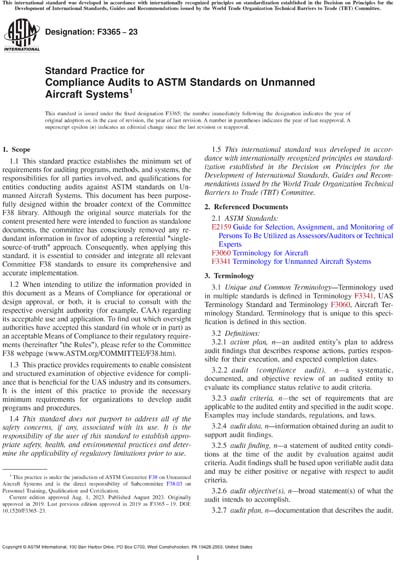Most recent
ASTM F3365-23
Standard Practice for Compliance Audits to ASTM Standards on Unmanned Aircraft Systems
1.1 This standard practice establishes the minimum set of requirements for auditing programs, methods, and systems, the responsibilities for all parties involved, and qualifications for entities conducting audits against ASTM standards on Unmanned Aircraft Systems. This document has been purposefully designed within the broader context of the Committee F38 library. Although the original source materials for the content presented here were intended to function as standalone documents, the committee has consciously removed any redundant information in favor of adopting a referential "single-source-of-truth" approach. Consequently, when applying this standard, it is essential to consider and integrate all relevant Committee F38 standards to ensure its comprehensive and accurate implementation.
1.2 When intending to utilize the information provided in this document as a Means of Compliance for operational or design approval, or both, it is crucial to consult with the respective oversight authority (for example, CAA) regarding its acceptable use and application. To find out which oversight authorities have accepted this standard (in whole or in part) as an acceptable Means of Compliance to their regulatory requirements (hereinafter "the Rules"), please refer to the Committee F38 webpage (www.ASTM.org/COMMITTEE/F38.htm).
1.3 This practice provides requirements to enable consistent and structured examination of objective evidence for compliance that is beneficial for the UAS industry and its consumers. It is the intent of this practice to provide the necessary minimum requirements for organizations to develop audit programs and procedures.
1.4 This standard does not purport to address all of the safety concerns, if any, associated with its use. It is the responsibility of the user of this standard to establish appropriate safety, health, and environmental practices and determine the applicability of regulatory limitations prior to use.
1.5 This international standard was developed in accordance with internationally recognized principles on standardization established in the Decision on Principles for the Development of International Standards, Guides and Recommendations issued by the World Trade Organization Technical Barriers to Trade (TBT) Committee.
ASTM International [astm]

